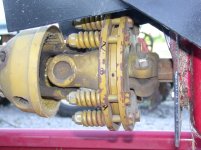It's a 1/2x3.5 bolt. I suspect when they put the slip clutch on it's standard to use the grade 8. The rig has maybe 40 hours on it. I figure since it's hit it's share of med sized rocks the bolt just got hammered.
I'm going to revisit how tight to keep the springs and do some experimenting with tension over the next few weeks.
I'm going to revisit how tight to keep the springs and do some experimenting with tension over the next few weeks.

